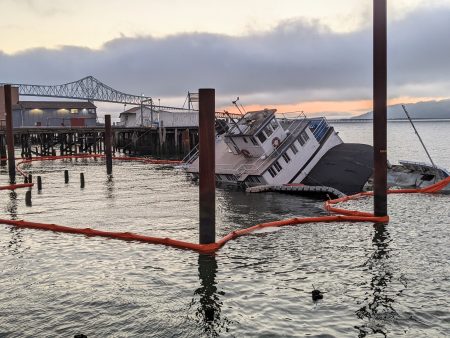
The U.S. Coast Guard says it still isn’t clear what caused the sinking of a historic river ferry near downtown Astoria last week.
The Tourist No. 2 capsized at a floating dock west of the Sixth Street viewing platform where the vessel had been moored for some time.
No one was onboard the ferry when it sank. Good Samaritan boats that responded when the vessel began to take on water and passersby have reported fuel leaks and a strong smell of diesel in the air. Booms have been set around the ferry to contain any fuel.
Petty Officer 3rd Class Diolanda Caballero, a spokesperson for the Coast Guard, said they don’t know if any other pollutants besides diesel have leaked, but the Coast Guard is still evaluating the pollution threat.
A lack of records about the ferry has complicated the response.
The Coast Guard does not have an estimate for how much fuel was onboard — although Caballero said the vessel took on 500 gallons of diesel several weeks ago. Christian Lint, the vessel’s owner, has said he does not have records of the mechanics of the vessel.
Lint also told the Coast Guard he does not have the money to fund cleanup efforts. The Coast Guard is making use of the Oil Spill Liability Trust Fund as a result. More than $65,000 has gone to pollution response efforts so far and up to $200,000 has been authorized.
Caballero noted that the Coast Guard is only involved with pollution response, and will not be involved in future salvage efforts. The agency is working with local contractors to stabilize the vessel, which involves refloating the ferry so oil can be removed.
The ferry is located outside of shipping lanes and currently does not present any threat to other vessels on the Columbia River.
In an update posted to Facebook, Astoria Mayor Bruce Jones, a retired commander of Coast Guard Sector Columbia River, noted that the National Pollution Funds Center is not authorized to pay for further work.
“Unless the state provides (other) agency funding to remove the wreck, transport it to a safe location and appropriately dispose of it, the wreck could simply be dropped back in place,” the mayor wrote. “The ferry would inevitably break up, representing an unacceptable hazard to navigation, to the fuel dock nearby and to other waterfront structures.”
Jones has requested involvement from the Oregon Department of Environmental Quality and the Department of State Lands to remove the ferry.
The ferry was illegally moored on Department of State Lands property. The state sent Lint a warning and then a citation 2021. Jones said the state described Lint as “nonresponsive” to both notices.
To Jones, the situation with the ferry now is an example of issues faced statewide when derelict or abandoned vessels sink at docks and ports. There is no one state agency tasked with responding wholly to such situations nor is there adequate funding provided to the Oregon Marine Board, which deals with the removal of recreational vessels.
But Jones said the state has been very responsive to his inquiries as he tries to coordinate a response to the ferry once the pollution issue has been addressed — and he has hopes that a broader discussion about the state’s response to derelict and abandoned vessels is poised to become more of a priority.
As for the ferry itself, he said there are people in Astoria who are not surprised by how things turned out given the age of the Tourist No. 2, the amount of work it needed and the expenses associated with restoring and maintaining it.
“I would say it was very predictable right from the start that it was going to end badly,” Jones said, adding that a lot of people have dreams when it comes to these older boats.
“But unless someone with deep pockets is in there from the beginning, they usually don’t end well.”
The Tourist No. 2 was the focus of a restoration campaign by a local nonprofit, but the group was unable to raise the funds needed to fully restore the vessel and abandoned the project. The historic wooden ferry, built in the 1920s, was used to shuttle cars and people back and forth between Oregon and Washington state before the Astoria Bridge was built.
This story is part of a collaboration between The Astorian and Coast Community Radio.
